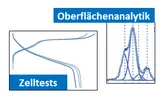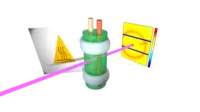Chair of Inorganic Chemistry with Focus on Novel Materials, Prof. Dr. Thomas Fässler
Through the synthesis and analysis of inorganic lithium-ion conductors, general properties of ionic conductivity in solids are investigated and new materials for lithium-ion batteries are developed.
Chair of Technical Electrochemistry (TEC), Prof. Dr. Hubert Gasteiger
Our activities encompass the characterization of next generation cathode materials (Ni-rich or Li-/Mn-rich NMC, LNMO) with operando analytical techniques (OEMS, XRD, XAS, EIS), optimization of commercial calcination and washing steps, as well as surface stabilization of cathode active materials by generating a resilient protection layer.
Professorship for Synthesis and Characterisation of Innovative Materials, Prof. Dr. Tom Nilges
Here, the researchers are working on determining, optimising and understanding ion dynamics in solids. Here, they vary the surrounding matrix of ions and then determine the nature of the matrix and the mobility and distribution of the ions in the crystalline and amorphous organic and inorganic solids using electrochemical, spectroscopic and diffraction analytical techniques.
Institute for Silicon Chemistry and WACKER-Chair of Macromolecular Chemistry, Prof. Dr. Bernhard Rieger
The research team is working on the synthesis and characterisation of new ion-conductive polymers as electrolyte solvents for lithium-ion batteries.
Chair of Digital Catalysis, Prof. Dr. Helge Stein
Our research group performs data-driven, high-throughput materials research by integrating laboratory automation with machine learning and data management. We rapidly generate diverse materials libraries through high-throughput combinatorial synthesis. Our automated mixing systems, robotic precipitation reactors, and electrochemical reactors allow precise control of synthesis conditions. We use spin coating, reactive magnetron sputtering, blade coating, and sequential electrodeposition for uniform and gradient material synthesis. These methods accelerate material development, reduce time to market, and improve our understanding of material properties in various applications. Our methods are scalable from mm2 to m2.
Physics of Energy Conversion and Storage, Prof. Aliaksandr Bandarenka
We use cathodic electrodeposition to synthesise thin films of Prussian blue analogues. We are investigating these as electrodes in water-based sodium-ion batteries for power grid applications, for example, and determining their performance. By varying the chemical composition of the Prussian blue analogues, we can create a wide range of electrodes and manipulate their properties. One of our goals is to understand the relationship between physical principles and the resulting electrochemical behaviour of the electrodes.
Chair of Functional Materials, Prof. Dr. Peter Müller-Buschbaum
The chair investigates new materials for use in batteries, such as polymer-based solid electrolytes, nanostructured anode and cathode materials. The internal structure is characterised with X-ray and neutron scattering. Ageing and degradation processes are addressed with in-operando studies.
TUM-ZWE at the research neutron source (FRM II), Gruppe Advanced Materials, Dr. habil. Ralph Gilles
For materials research, the characterisation of materials (crystallographic structure, phase transformations, morphology, particle size, defect characterisation) or their modification is of central importance. Thanks to the unique properties of neutrons with the various measurement methods as well as positrons, the Advanced Materials group can observe and quantify central issues such as the distribution of Li-ions in active materials of battery cells in-situ and operando.








